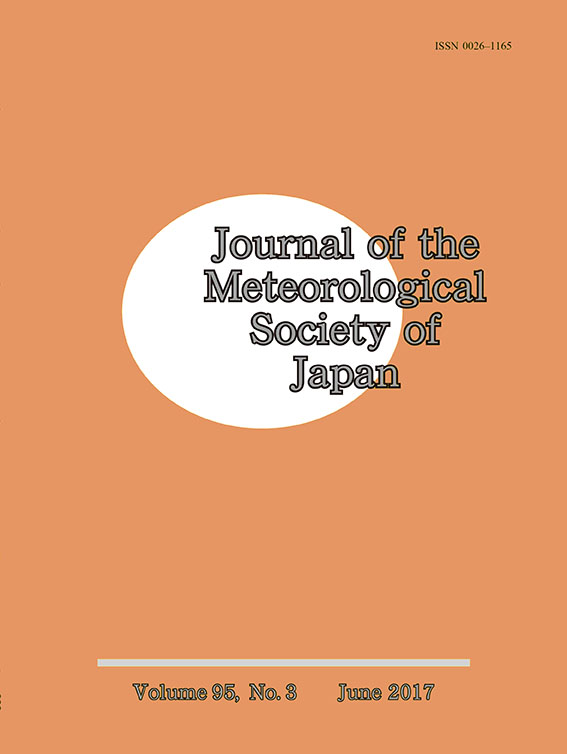
- Issue 6 Pages 345-
- Issue 5 Pages 287-
- Issue 4 Pages 217-
- Issue 3 Pages 171-
- Issue 2 Pages 71-
- Issue 1 Pages 1-
- |<
- <
- 1
- >
- >|
-
Yuhji KURODA, Kunihiko KODERA2017Volume 95Issue 3 Pages 171-180
Published: 2017
Released on J-STAGE: April 28, 2017
Advance online publication: January 24, 2017JOURNAL FREE ACCESS
Supplementary materialThis paper proposes a new simple method of multivariable maximum covariance analysis (MMCA) for extracting common variability from multiple (more than two) datasets that expands the singular value decomposition analysis method. The method is based on iteration of a recurrence equation derived by a dual relationship between pattern vectors and time coefficients. Two approaches of the method are proposed, one using the extreme of a summation of covariances (sum MMCA) and the other using the product of covariances (product MMCA). Both approaches are demonstrated by successfully extracting the variability related to the Arctic Oscillation from three monthly-mean meteorological datasets. The method is useful because it is easily programmed and is computationally inexpensive. The method can be applied to an arbitrary number of datasets, although a complete set of the product MMCA method cannot be applied to an even number of datasets.
View full abstractDownload PDF (1068K) -
Yanru ZHAO, Wenqian MAO, Kequan ZHANG, Yining MA, Haifei LI, Wenyu ZHA ...2017Volume 95Issue 3 Pages 181-197
Published: 2017
Released on J-STAGE: April 28, 2017
Advance online publication: February 24, 2017JOURNAL FREE ACCESS
Supplementary materialBased on the ERA-20C, climatic variations of the boundary layer height (BLH) over arid and semiarid areas in East Asia and North Africa that span 1900-2010 were analyzed. In East Asia, the BLH exhibited a descending trend from arid region centers to the periphery. Over the past 111 years, the BLH has had a rising trend of 14.0 m decade−1. in the representative region (EA1) of the eastern areas with the 111-year average of 725 m and a decreasing trend of −1.6 m decade−1. in the representative region (EA2) of the western areas with the 111-year average of 792 m. From the mid-1960s to 1970s, EA1's BLH had a sharp rise that caused the average to increase by 93 m after the 1980s. In North Africa, the BLH exhibited a high spatial distribution in the western and southern areas and a relatively low spatial distribution in the eastern and northern areas. Over the past 111 years, the BLH has had a rising trend of 9.7 m decade−1. in the representative region (NA1) of the southwestern region with the 111-year average of 915 m and a decreasing trend of −6.3 m decade−1. in the representative region (NA2) of other regions with the 111-year average of 882 m. In the 1940s and the 1970s, NA1's BLH had two obvious increases that caused the average to increase by 51 m and 22 m, respectively, while NA2's BLH had two obvious declines that caused the average to decrease by 48 m and 7 m, respectively. On the spatial distribution, the BLH, sensible heat flux, latent heat flux, and volumetric soil water had a good corresponding relationship. On the temporal change, the BLH in East Asia had a stronger correlation with thermodynamic factors, whereas the BLH in North Africa had a stronger correlation with dynamic factors. Besides, the upper-level stratification also has some influence on the BLH's change.
View full abstractDownload PDF (3771K) -
Jiangman WANG, Chun LI2017Volume 95Issue 3 Pages 199-211
Published: 2017
Released on J-STAGE: May 27, 2017
Advance online publication: March 22, 2017JOURNAL FREE ACCESS
Supplementary materialThe Pacific Decadal Oscillation (PDO) and North Pacific Gyre Oscillation (NPGO) are the two dominant low-frequency modes in the North Pacific. This study focused on the simulation capability of the two leading low-frequency modes in current-coupled models, based on 24 coupled model outputs from the Coupled Model Intercomparison Project Phase 5 (CMIP5). Results showed that most of these models captured the two low-frequency modes, but the air–sea coupling relationship (covariability of the ocean low-frequency modes with the atmospheric forcing modes) captured by CMIP5 models had drastic differences. Four models (CCSM4, CESM-WACCM, MIROC5, and NorESM1-M) not only captured the spatial and temporal characteristics of the PDO and NPGO modes but also simulated their air–sea coupling relationships. Therefore, we selected these four models to examine changes in the PDO and NPGO modes under different global warming scenarios using RCP4.5 and RCP8.5 forcing (RCP: Representative Concentration Pathway). In future RCP scenarios, the spatial patterns of PDO and NPGO showed no obvious changes. However, the dominant periods of the PDO and NPGO modes were shorter, which is consistent with faster oceanic Rossby waves induced by enhanced upper oceanic stratification in the warming scenarios.
View full abstractDownload PDF (10458K)
- |<
- <
- 1
- >
- >|